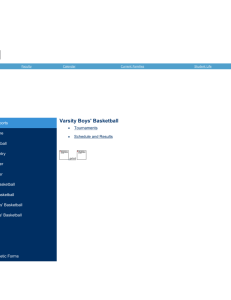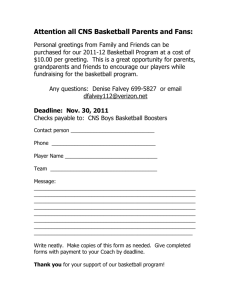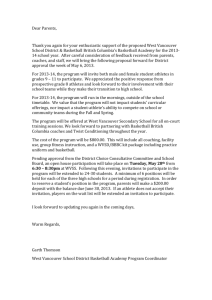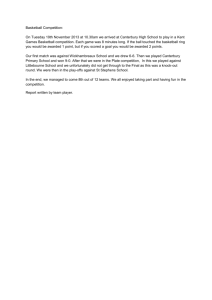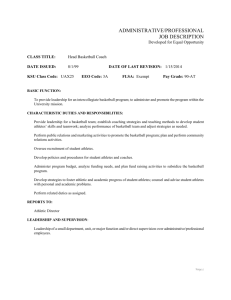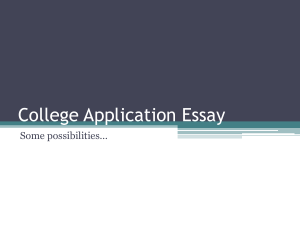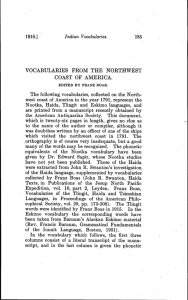Athlete, Spokesman and Rolemodel?
advertisement
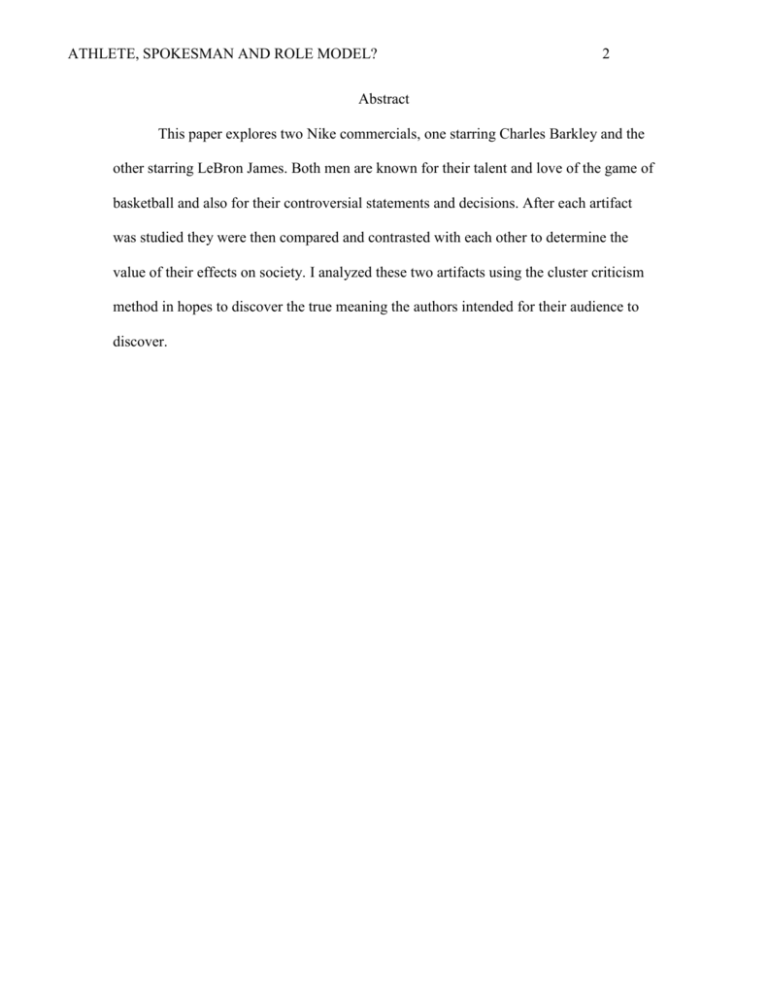
ATHLETE, SPOKESMAN AND ROLE MODEL? 2 Abstract This paper explores two Nike commercials, one starring Charles Barkley and the other starring LeBron James. Both men are known for their talent and love of the game of basketball and also for their controversial statements and decisions. After each artifact was studied they were then compared and contrasted with each other to determine the value of their effects on society. I analyzed these two artifacts using the cluster criticism method in hopes to discover the true meaning the authors intended for their audience to discover. ATHLETE, SPOKESMAN AND ROLE MODEL? 3 Athlete, Spokesman, and Role Model? Boys and girls of all ages look up to professional athletes as role models and heroes. Whether it is Tiger Woods in golf, Dale Earnhardt in racing, or Shaq in basketball, children will always have an “idol” that they want to be like when they grow up. More and more, we are seeing these athletes oppose the idea of being an example for children to look up to. I agree celebrities and athletes are not the best source of guidance when struggling through the adolescent years, but it’s hard to tell children to stop loving someone or something they admire. Parents should make more of an effort to mediate the amount of exposure their children are getting to the detailed lives of these athletes. In supporting my argument, I will look at the two Nike commercials, one of Charles Barkley “I am not a role model”, and the Lebron James commercial “What should I do?” Each commercial takes two professional basketball stars and portrays them to the public in a new way: athletes who only want to be athletes. Barkley argues that he is not responsible for raising other’s children or teaching them right from wrong. James simply revisits Barkley’s commercial by saying “I AM NOT A ROLE MODEL.” This one statement in the middle of another commercial brings back the meaning Barkley’s commercial brought in 1993. Each commercial gives insight to what each basketball player believes about being a role model. I am studying these two commercials because I agree with the players. It is not their job to raise children and teach them right from wrong. It is great that children have dreams and want to aspire to the level of talent professional athletes display. It is the parent’s job to teach children to be individuals, and live their own lives instead of wanting everything exactly the way LeBron has it. Studying this article will bring ATHLETE, SPOKESMAN AND ROLE MODEL? 4 understanding and knowledge to the audience. If athletes do not want to be seen as role models and influential people they will continue to act in any careless way they want. The next generation will emulate the lifestyle unless parents step in and direct their children. To get a closer look at the artifact I’ll study it trough the cluster criticism lens. This method will help me make sense of this visual artifact. I can see into the meaning but want to know more. When I first saw Charles Barkley’s commercial I hated it but didn’t know why. It seemed so arrogant. At the initial sight of LeBron James’ commercial, I loved it and only had a slight idea why. I want to look into more of why they were created and the meaning behind them and their messages to the public. This criticism will give more clear understanding to these artifacts. Cluster criticism is a method of determining the meaning hidden in a text based on frequency and intensity of key terms. “Cluster criticism analysis follows a three-step process: (1) identifying key terms in the artifact; (2) charting the terms that cluster around the key terms; and (3) discovering an explanation for the artifact” (Foss, 2008). In identifying key terms, look for the ones that appear the most often. Those are the ones most prevalent in the rhetor’s mind. Next, the critic will want to examine what surrounds the identified key terms and finally draw a conclusion on what it all means. Charles Barkley wrote the text for his 1993 Nike air commercial as a clear message to the public. Throughout the ad, he frequently addresses who he is and who he is not. “I am not a role model”, “I am not paid to be a role model”, “I am paid to wreak havoc on the basketball court” and “parents should be role models” are the phrases included in the ad. Within those potent phrases, there are four key terms vital to the ATHLETE, SPOKESMAN AND ROLE MODEL? 5 message Barkley is sending: I, not, basketball and role model. The term “I” gives significance to the point of view this text is coming from. Barkley himself wrote the text and made it clear to the public that the bad boy of basketball himself was not responsible for anyone else. While it is not obvious why Barkley was motivated to deliver this message, it is clear how he feels about being held accountable to anyone other than himself. The term “not” in the message communicates exactly who he is or in this case is not. He spends a great amount of time limiting himself to the parameters of the basketball court. “I am not a role model, I am not paid to be a role model” all define who Barkley is not. Leave it up to one of the original “bad boys” of basketball to define himself by everything he is not. Who is he? How does he identify and define himself? The third key word used was “basketball” and that is how Barkley defines himself in his commercial; “I am paid to wreak havoc on the basketball court.” He is and only is a basketball player. He doesn’t consider himself to be a role model, a positive influence or a father figure to any unfortunate children without one. Which brings me to my last key term, “role model.” Barkley calls out parents and teachers telling them to step up to the challenge. His words encourage them to be the people children look up to and want to be someday. In a salon.com article in 2000, Barkley said, “A million guys can dunk a basketball in jail, should they be role models?" He’s got a point. The only major difference between Barkley and the guys “dunking” in prison is his celebrity status and the public’s accessibility to any information about him, good or bad. He is famous and it is that reason that people want to look up to him. There are thousands of people across the country that are good at playing basketball and can dunk the ball. At the end of the day a slam-dunk is still 2 points on the scoreboard and a ATHLETE, SPOKESMAN AND ROLE MODEL? 6 celebrity is another human being. Like every other person, star athletes make bad choices and they make mistakes. Barkley wants to be a “bad boy” and he wants to play basketball but he does not want to have anything to do with being an influence for future generations. If he feels strongly enough about this to write and film a commercial aired on national television, then parents and teachers should want to do more to keep their children from looking up to him. He will wreak havoc on more than just the basketball court. LeBron James is a more recent case study. At the end of the 2009-2010 NBA season James made the decision to leave his long time home and team in Cleveland Ohio to sign with the Miami Heat. Cavalier fans in Cleveland and all across the country were outraged by this decision. In response to James’ “betrayal” the fans were recorded burning his former basketball jersey and putting curses on him. In reply to all of the negative attention, LeBron James did his own commercial for Nike. In this ad, there weren’t specific key terms that stuck out, but phrases. The most important phrases, “What should I do?” and “Should I?” combined together are repeated over twenty times throughout the video. Another key phrase is “Who you want me to be.” Lastly, the final major theme in the commercial is the collection of assumed motives: championships, rings, and money. The question “What should I do?” answers everything James was criticized for. He had so many different people trying to persuade him in his decision to stay with Cleveland or go to Miami. Once the decision was made, people still wanted him to do what they thought was right. Even more changes were asked of him. Fans thought if he didn’t want to be associated with the Cavaliers anymore than he should get rid of all ATHLETE, SPOKESMAN AND ROLE MODEL? 7 evidence that he ever was associated with them, including the removal of his tattoo. The second phrase and the answer to the question “what should I do?” is “Should I be who you want me to be?” This answer and proposition of a new question is the most confrontational way James could address the public. It was his point of view on all of the criticisms he received. James made the decision to move for himself. He did not do it for other people and he isn’t apologizing for his decision. The last set of key terms is grouped together representing why people thought he left Cleveland. James’ fans saw a trader that abandoned his team, a team that lost its chance at a championship when he chose to leave. They assumed he only cared about championship rings, more money and fame. No one knows for sure why LeBron James made the choice he did, but this change shouldn’t be any more upsetting than Shaq leaving the Los Angeles Lakers to go to the Orlando Magic. James never really answers the questions outside of the key phrases, but he addresses each and every issue he was faced with in the summer of 2010 when he was going through his decision process. Discussion The LeBron James commercial takes a different approach than Charles Barkley’s commercial. Barkley had a strong arrogance present in his ad, but what more would one expect from the man who was charged with “conduct unbecoming of a role model” during his years on the court? He took the offensive side where James’ was forced to play defense. Each commercial does a good job of getting each player’s point across effectively. Whether or not we as the audience know the motivation behind each ad, when we see them they invoke certain emotions. When I first saw the Barkley commercial I was disgusted. I grew up watching Barkley play basketball in the era of the ATHLETE, SPOKESMAN AND ROLE MODEL? 8 Charlotte Hornets and thought he could do no wrong. Much to my surprise he wanted nothing to do with my looking up to him. I played the commercial over and over and finally began to see things through his eyes. While the method of delivery is a little offensive, the message holds true. His message was so truthful that it was revisited seventeen years later in the middle of another important message: LeBron’s commercial. Speculation concludes that the “I am not a role model” quote was included in James’ commercial because of Barkley’s own criticism towards James’ decision. It seems hypocritical that someone with such a distinct message and ambition to be seen only as a basketball player would be willing to criticize someone who was making a strategic career move as a professional athlete. This move may not have been the “right” move or the best move at the end of the day, but it was made, and James is playing well with his new teammates, especially after the recent victory over his former team. There is enough conflict going on in the lives of adolescent children without the excess drama, rebellion and politics of professional basketball athletes. At the end of the day, all we need from the NBA is a good competitive game of basketball. We have taken a lighthearted form of healthy entertainment and turned it into a media controversy. Barkley is paid to play basketball, and we pay to watch him play, and only play. Ideally, this analysis would be shared with parents. It will be suitable for publication in a parental journal or magazine. It could also be broadcast via NPR or a podcast on a website. Each of these outlets reaches parents and educators. They are trusted sources of information. If parents and teachers hear the ideas and the analysis, they will begin thinking about what their children value and who they “idolize.” They ATHLETE, SPOKESMAN AND ROLE MODEL? 9 could then begin to encourage individuality and supportive ways to accomplish their dreams for their lives. ATHLETE, SPOKESMAN AND ROLE MODEL? 10 References Nike Basketball: Lebron Rise. (2010). Retrieved December 6, 2010, from http://www.youtube.com/watch?v=cdtejCR413c Sharp, A. (2010). LeBron James’ New Nike Commercial: What Should He Do? Retrieved December 6, 2010 from http://www.sbnation.com/nba/2010/10/25/1773499/lebron-james-new-nikecommercial-video-thoughts Platt, L. (2000). Charles Barkley: The most fascinating sports figure since Muhammad Ali, he gave rise to a generation of hip-hop athletes. Retrieved December 6, 2010 from http://www.salon.com/people/bc/2000/05/30/barkley Nike Air Commercial Charles Barkley. (1993). Retrieved December 6, 2010 from http://www.youtube.com/watch?v=nMzdAZ3TjCA Foss, Sonja K. (2009). Rhetorical Criticism: Exploration and Practice. Long Grove, Illinois: Waveland Press, Inc.
